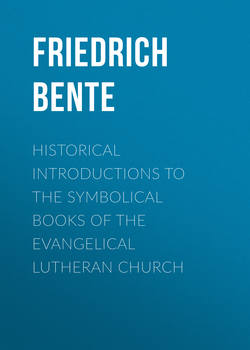Читать книгу Historical Introductions to the Symbolical Books of the Evangelical Lutheran Church - Bente Friedrich - Страница 1
I. The Book of Concord, or The Concordia
1. General and Particular Symbols
ОглавлениеBook of Concord, or Concordia, is the title of the Lutheran corpus doctrinae, i.e., of the symbols recognized and published under that name by the Lutheran Church. The word symbol, sumbolon, is derived from the verb sumballein, to compare two things for the purpose of perceiving their relation and association. Sumbolon thus developed the meaning of tessara, or sign, token, badge, banner, watchword, parole, countersign, confession, creed. A Christian symbol, therefore, is a mark by which Christians are known. And since Christianity is essentially the belief in the truths of the Gospel, its symbol is of necessity a confession of Christian doctrine. The Church, accordingly, has from the beginning defined and regarded its symbols as a rule of faith or a rule of truth. Says Augustine: "Symbolum est regula fidei brevis et grandis: brevis numero verborum, grandis pondere sententiarum. A symbol is a rule of faith, both brief and grand: brief, as to the number of words, grand, as to the weight of its thoughts."
Cyprian was the first who applied the term symbol to the baptismal confession, because, he said, it distinguished the Christians from non-Christians. Already at the beginning of the fourth century the Apostles' Creed was universally called symbol, and in the Middle Ages this name was applied also to the Nicene and the Athanasian Creeds. In the Introduction to the Book of Concord the Lutheran confessors designate the Augsburg Confession as the "symbol of our faith," and in the Epitome of the Formula of Concord, as "our symbol of this time."
Symbols may be divided into the following classes: 1. Ecumenical symbols, which, at least in the past, have been accepted by all Christendom, and are still formally acknowledged by most of the evangelical Churches; 2. particular symbols, adopted by the various denominations of divided Christendom; 3. private symbols, such as have been formulated and published by individuals, for example, Luther's Confession of the Lord's Supper of 1528. The publication of private confessions does not necessarily involve an impropriety; for according to Matt. 10, 32 33 and 1 Pet. 3, 15 not only the Church as a whole, but individual Christians as well are privileged and in duty bound to confess the Christian truth over against its public assailants. Self-evidently, only such are symbols of particular churches as have been approved and adopted by them. The symbols of the Church, says the Formula of Concord, "should not be based on private writings, but on such books as have been composed, approved, and received in the name of the churches which pledge themselves to one doctrine and religion." (CONC. TRIGL., 851, 2.)
Not being formally and explicitly adopted by all Christians, the specifically Lutheran confessions also are generally regarded as particular symbols. Inasmuch, however, as they are in complete agreement with Holy Scripture, and in this respect differ from all other particular symbols, the Lutheran confessions are truly ecumenical and catholic in character. They contain the truths believed universally by true Christians everywhere, explicitly by all consistent Christians, implicitly even by inconsistent and erring Christians. Christian truth, being one and the same the world over is none other than that which is found in the Lutheran confessions.
